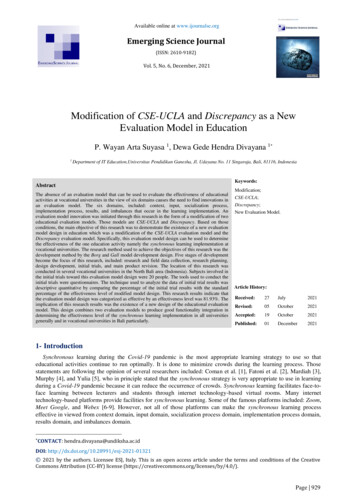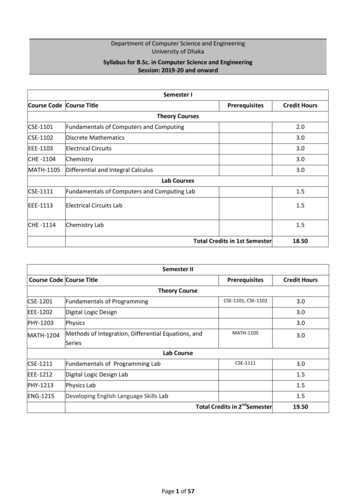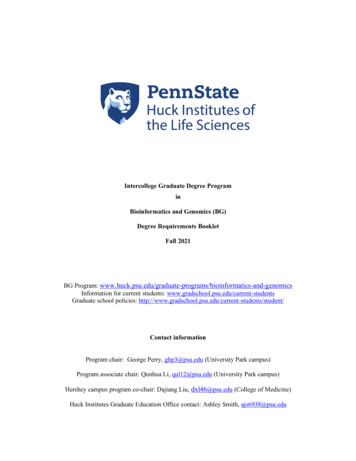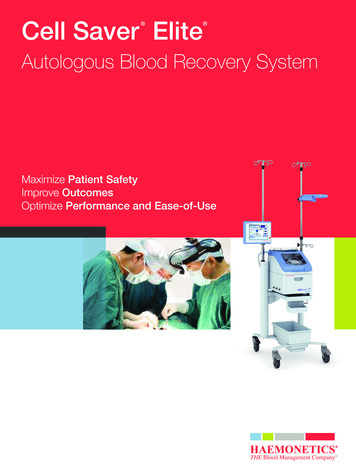
Transcription
Available online at www.ijournalse.orgEmerging Science Journal(ISSN: 2610-9182)Vol. 5, No. 6, December, 2021Modification of CSE-UCLA and Discrepancy as a NewEvaluation Model in EducationP. Wayan Arta Suyasa 1, Dewa Gede Hendra Divayana 1*1Department of IT Education,Universitas Pendidikan Ganesha, Jl. Udayana No. 11 Singaraja, Bali, 81116, IndonesiaKeywords:AbstractThe absence of an evaluation model that can be used to evaluate the effectiveness of educationalactivities at vocational universities in the view of six domains causes the need to find innovations inan evaluation model. The six domains, included: context, input, socialization process,implementation process, results, and imbalances that occur in the learning implementation. Anevaluation model innovation was initiated through this research in the form of a modification of twoeducational evaluation models. Those models are CSE-UCLA and Discrepancy. Based on thoseconditions, the main objective of this research was to demonstrate the existence of a new evaluationmodel design in education which was a modification of the CSE-UCLA evaluation model and theDiscrepancy evaluation model. Specifically, this evaluation model design can be used to determinethe effectiveness of the one education activity namely the synchronous learning implementation atvocational universities. The research method used to achieve the objectives of this research was thedevelopment method by the Borg and Gall model development design. Five stages of developmentbecome the focus of this research, included: research and field data collection, research planning,design development, initial trials, and main product revision. The location of this research wasconducted in several vocational universities in the North Bali area (Indonesia). Subjects involved inthe initial trials toward this evaluation model design were 20 people. The tools used to conduct theinitial trials were questionnaires. The technique used to analyze the data of initial trial results wasdescriptive quantitative by comparing the percentage of the initial trial results with the standardpercentage of the effectiveness level of modified model design. This research results indicate thatthe evaluation model design was categorized as effective by an effectiveness level was 81.93%. Theimplication of this research results was the existence of a new design of the educational evaluationmodel. This design combines two evaluation models to produce good functionality integration indetermining the effectiveness level of the synchronous learning implementation in all universitiesgenerally and in vocational universities in Bali particularly.Modification;CSE-UCLA;Discrepancy;New Evaluation Model.Article cepted:19October2021Published:01December20211- IntroductionSynchronous learning during the Covid-19 pandemic is the most appropriate learning strategy to use so thateducational activities continue to run optimally. It is done to minimize crowds during the learning process. Thosestatements are following the opinion of several researchers included: Coman et al. [1], Fatoni et al. [2], Mardiah [3],Murphy [4], and Yulia [5], who in principle stated that the synchronous strategy is very appropriate to use in learningduring a Covid-19 pandemic because it can reduce the occurrence of crowds. Synchronous learning facilitates face-toface learning between lecturers and students through internet technology-based virtual rooms. Many internettechnology-based platforms provide facilities for synchronous learning. Some of the famous platforms included: Zoom,Meet Google, and Webex [6-9]. However, not all of those platforms can make the synchronous learning processeffective in viewed from context domain, input domain, socialization process domain, implementation process domain,results domain, and imbalances domain.*CONTACT:hendra.divayana@undiksha.ac.idDOI: http://dx.doi.org/10.28991/esj-2021-01321 2021 by the authors. Licensee ESJ, Italy. This is an open access article under the terms and conditions of the CreativeCommons Attribution (CC-BY) license e 929
Emerging Science Journal Vol. 5, No. 6Based on the limitations of those platforms, it is necessary to carry out an in-depth evaluation to determine theeffectiveness of synchronous learning implementation. Many educational evaluation models were able to be used toevaluate the effectiveness of synchronous learning, included: CSE-UCLA model [10], Countenance model [11],Discrepancy model [12], Kirkpatrick model [13], Goal Oriented Evaluation model [14], and CIPP (Context-InputProcess-Product) model [15]. From those several models, none of them were able to show the level of effectiveness ofsynchronous learning completely and thoroughly based on the context domain, input domain, socialization processdomain, creation/implementation process domain, results domain, and imbalances domain. That statement is followingthe research results of Tripathi and Bansal [16], Esgaiar and Foster’s research [17], and Mubayrik’s research [18],which principally stated that each evaluation model has its evaluation component and its indicator characteristicsaccording to the object being evaluated. Certainly, between one evaluation model and another evaluation model it hasits advantages and disadvantages. Based on that, it can be generalization that no evaluation model can show the overalleffectiveness of object evaluated from various domains, so modifications to the evaluation models are needed.Therefore, it was necessary to modify the evaluation model to produce an appropriate evaluation model used inevaluating the effectiveness of synchronous learning implementation. One of the efforts was a modification of theCSE-UCLA model with the Discrepancy model. Principally, the CSE-UCLA (Center for the Study of EvaluationUniversity of California in Los Angeles) model is an evaluation model that has five evaluation dimensions (systemassessment, program planning, program implementation, program improvement, program certification) and is suitablefor use to evaluate service programs that help human life, included: e-learning, blended learning, e-government, libraryprograms, and so on [19,20]. Principally, the Discrepancy model is an evaluation model that functions to determine thelevel of gaps that occur in the implementation of a program/service by comparing evaluation results with evaluationstandards which refer to four evaluation components, included: definition, installation, process, and product [21, 22].The reason for making modifications to those two evaluation models is because they have evaluation componentsthat have similar functionality and complement each other. If those two models are combined, it can be used tocompletely and thoroughly evaluate the synchronous learning implementation in the viewed of the context domain,input domain, socialization process domain, implementation process domain, results domain, and imbalances domain.The context domain can be evaluated using the system assessment component of the CSE-UCLA model and thedefinition component of the Discrepancy model. The input domain can be evaluated using the program planningcomponent of the CSE-UCLA model and the installation component of the Discrepancy model. The socializationprocess domain can’t be evaluated using the Discrepancy model component, but it can be evaluated using the programimplementation component of the CSE-UCLA model. The implementation process domain can be evaluated using theprogram improvement component of the CSE-UCLA model and the process component of the Discrepancy model. Theresults domain can be evaluated using the program certification component of the CSE-UCLA model and the productcomponent of the Discrepancy model that shows the effectiveness level of synchronous learning implementation. Theimbalances domain can’t be evaluated using the component of the CSE-UCLA model, but it can be evaluated using theproduct component of the Discrepancy model that shows the imbalance in the synchronous learning implementation.The similarity in the functionality of those two evaluation models is indicated by the existence of components areowned by each model which can be used to evaluate the context domain, input domain, implementation processdomain, and results domain. The functionality which complementary of the two evaluation models is indicated by theexistence of the CSE-UCLA component which is used to complements the limitation of the Discrepancy components’function and otherwise, the Discrepancy component which complements the limitation of the CSE-UCLA components’function. The program implementation component of the CSE-UCLA model complements the limitation of theDiscrepancy components’ function which is unable to evaluate the socialization process domain. The productcomponent in the Discrepancy model which specifically functions to evaluate the imbalance level can be used tocomplement the limitation of the CSE-UCLA components’ function which is unable to evaluate the imbalancesdomain. The importance of making modifications to the two models raises questions in this research. The researchquestion: “How is the modified form of the CSE-UCLA model and the Discrepancy model as new evaluation model ineducation that used to determine the effectiveness level of synchronous learning?”Some of the results and limitations of the previous research were used to show this research position and itscontributions. The contributions of this research were used as a solution to the problem solving of the previousresearch. Research conducted by Mohmmed et al. [23] showed the use of the CIPP model in evaluating theeffectiveness of synchronous and asynchronous-based distance learning during the Coronavirus pandemic. Theresearch results of Mohmmed et al. only were able to show the effectiveness of the context domain, input domain,process domain, and product domain. The research results of Mohmmed et al. weren’t able to show the socializationprocess of the existence of synchronous learning and weren’t able to show imbalances in the implementation of thislearning. The research was conducted by Sudarwati & Rukminingsih [24] showed the use of the Discrepancyevaluation model to measure the effectiveness level of synchronous e-learning. The research results of Sudarwati &Rukminingsih only were able to show the imbalances that occur in the implementation of synchronous e-learning butweren’t able to show the details of the mechanisms and processes of socializing the existence of synchronous elearning to the schools’ community. Divayana et al.’s research [25] showed the use of the CSE-UCLA model toPage 930
Emerging Science Journal Vol. 5, No. 6evaluate the learning effectiveness of expert system subjects based on mobile technology. The results of Divayana etal.’s research indicated the effectiveness of the learning implementation of expert system subjects from the contextdomain, input domain, process domain, results domain, and also the socialization process domain. However, the resultsof Divayana et al.’s research weren’t able to show imbalances in the learning process. The efforts to facilitateunderstanding toward some of the results of previous research that background this research, it is necessary to showthrough a research roadmap. The roadmap for this research can be seen in Figure 1.2020Research Title: Development ofANEKA Value-BasedCountenanceEvaluation ModelIntegrated with theTri Hita KaranaConcept to Improvethe Characters andResearchTitle:Quality of ComputerResearch Title:Learning for ICT ProgramEvaluation: Empowerment of theVocational Schools’Implementation ofCSE-UCLA Model inStudents in BaliTourismVillagethe Evaluation of theBy:Divayana, et al. [28]DevelopmentBlended LearningBy: Sudirtha et al. [27]Program at SMAResearch Results:Negeri 1 UbudResearch Results: Research resultsBy: Suyasa et al. [26]showed priority The evaluation studyaspects that cause anResearch Results:of the Sambanganincrease in thetourismvillage The evaluation ofdevelopment program character and qualityblended learningof computer learningwith the CSE-UCLAprogramfor ICT Vocationalevaluation modelimplementation atSchools’ students inapproachwasabletoSMA Negeri 1 UbudBali.provide several newhad gone well. It wasrecommendations inindicated by thedetermining program Research Constraints:evaluation results ofoptimization. Research results hadeach evaluation2018component of theCSE-UCLA modelthat had shown agood category andspecifically excellenton the systemassessmentcomponent.2019Research Constraints: Research results hadnot shown detailsabout the priorityaspects thatdetermine theprogramoptimization.2021Research Title: Modification of CSEUCLA andDiscrepancy as a NewEvaluation Model inEducationBy: Suyasa and DivayanaResearch Purposes: Realize of the CSEUCLA evaluationmodel design wasmodified with theDiscrepancy model, soit was able to show theimbalances that occurin the learningimplementation.Modification of theCSE-UCLA Modeland DiscrepancyModel to SupportEvaluation of theEffectiveness of theImplementation ofSynchronousLearning atVocationalUniversitiesResearch Results thatExpected: CSE-UCLA evaluationmodel design modifiedwith Discrepancymodel.not shown detailsabout the imbalancesthat occur in thelearningimplementation.Research Constraints: Difficulty todetermine the mostdominant aspect andcomponent ininfluencing anddetermining theoptimization ofprogramimplementation.Figure 1. Research Roadmap.Based on the visualization of Figure 1, it appears that the results of this research were in the form of a modifiedCSE-UCLA evaluation model design with the Discrepancy model. The presence of this model design is an answer toseveral obstacles from previous studies starting from 2018-2020. The evaluation model design resulted from thisresearch can be used as a description of the process carried out in evaluation activities toward the effectiveness of thesynchronous learning implementation at vocational universities.Page 931
Emerging Science Journal Vol. 5, No. 62- Material and Methods2-1- Research Goal, Research Approach, and Research MethodThe goal of this research was to determine the modified form of the CSE-UCLA model and the Discrepancy modelused to determine the effectiveness level of synchronous learning. The effort was made to achieve that goal was toconduct research using a development approach. The development method utilized in this research was based on thedevelopment design of the Borg and Gall model which consists of ten stages [29,30]. Those ten stages of developmentcan be seen in Figure 2.1Research and Field Data Collection2Research Planning3Design Development4Initial Trials5Main Product Revision6Field Testing7Operational Product Revision8Operational Field Testing9Final Product Revision10Dissemination and Implementationof the Final ProductFigure 2. The Research Stages that Refer to the Borg and Gall Design.Specifically for research in 2021 was conducted several development stages, included: the stage of research andfield data collection related to the CSE-UCLA and Discrepancy concepts which were used as the knowledge base tomake evaluation model design, stage of research planning, stage of design development, stage of initial trials, and thestage of main product revision toward the evaluation model design which is the results of modification from the CSEUCLA model and Discrepancy model.Page 932
Emerging Science Journal Vol. 5, No. 62-2- Research Location, Sample, and Technique of Data CollectionThis research was conducted in several vocational universities in Bali Province, especially in North Bali. Thereason for this research location in the North Bali area was because this area is the center of education in Bali, with thecharacteristics of students who came from various regions in Indonesia. Besides, access to information technology inNorth Bali is not superior compare with South Bali. However, this precisely makes it easier to determine theeffectiveness of synchronous learning. If the area that has limited information technology can effectively carry outsynchronous learning, so logically, the area that already has superior facilities and access to information technology,certain can carry out synchronous learning more effectively.Subjects in this research were determined using a purposive sampling technique. Purposive sampling wasconducted by determining the parties directly related to the implementation of synchronous learning at vocationaluniversities in North Bali. The reason for using this purposive sampling technique was because this technique wasvery appropriate to be used to obtain complete information from parties who had knowledge and experience ofsynchronous learning [31, 32]. Subjects involved in this research were three research members and three field workers,especially at the stage of research and field data collection, research planning, and design development. The subjectsinvolved in the initial trials of the evaluation model design were ten evaluators and ten lecturers in the field ofvocational from several universities in North Bali. The subjects involved in the main product revision were threemembers of the research team in this research.The data collection tools of the initial trial results toward the model design were questionnaires. The questionnairesconsist of 15 questions. Each question was assessed using five types of assessment scores that follow the Likert scale.A score of 5 means excellent, a score of 4 means good, a score of 3 means enough, a score of 2 means less, and a scoreof 1 means poor [33-35]. The content validity tests of the questionnaire questions were carried out by two educationalevaluation experts. The formula used to content validity tests of the questionnaire questions was the Gregory formula.The Gregory formula can be seen in Equation 1 [36-38].𝐶𝑜𝑛𝑡𝑒𝑛𝑡 𝑉𝑎𝑙𝑖𝑑𝑖𝑡𝑦 𝐷/(𝐴 𝐵 𝐶 𝐷)(1)Notes: 𝐴 cell indicating disagreement between the two judges; 𝐵 and 𝐶 cells indicating the difference in viewsbetween the judges; 𝐷 cell indicating valid agreement between the two judges.2-3- Analyzing of DataThe analysis technique of the questionnaire questions was carried out by comparing the results of the contentvalidity tests with the content validity score standards which refer to the Guilford category. The categorization ofcontent validity refers to Guilford [39,40], included: a validity score of 0.80 to 1.00 means very high validity, 0.60 to0.80 means high validity, 0.40 to 0.60 means sufficient validity, 0.20 to 0.40 means low validity, 0.00 to 0.20 meansvery low validity, a validity score 0.00 means invalid.The analysis technique used in analyzing the trial results of the modified evaluation model design was quantitativedescriptive. This technique was done by comparing the percentage of trial results with the percentage of theeffectiveness standards of the modified evaluation model design. The formula was used to calculate the percentage oftrial results follows Equation 2 [41], while the percentage of the effectiveness standards of the modified evaluationmodel design follows the percentage range of effectiveness scores. The percentage score in the range of 0% to 39%means poor, the percentage score in the range of 40% to 64% which means less, the percentage score in the range of65% to 79% means enough, the percentage score in the range 80% to 89% means effective, and the percentage scorein the range of 90% to 100% means excellent [42].𝑃𝑒𝑟𝑐𝑒𝑛𝑡𝑎𝑔𝑒 𝑜𝑓 𝑇𝑟𝑖𝑎𝑙 𝑅𝑒𝑠𝑢𝑙𝑡𝑠 𝑡𝑜𝑤𝑎𝑟𝑑 𝐷𝑒𝑠𝑖𝑔𝑛 (𝑓 𝑁 1 ) 100%(2)Notes: 𝑓 total of acquisition values; 𝑁 total of maximum scores.3- Results and DiscussionThe results obtained at the stage of research and field data collection were data related to components and aspectsof the CSE-UCLA evaluation model and the Discrepancy evaluation model which were used as references inevaluating the implementation of synchronous learning. The components and aspects of the CSE-UCLA evaluationmodel completely can be seen in Table 1, while the components and aspects of the Discrepancy evaluation model canbe seen in Table 2.Page 933
Emerging Science Journal Vol. 5, No. 6Table 1. Components and Aspects of the CSE-UCLA Evaluation Model as References for Evaluating the Implementation of SynchronousLearning at Vocational Universities in North amCertificationCodes ofAspectsEvaluation AspectsAP1The purpose of synchronous learning implementationAP2Support from the academic community in each vocational university in North BaliAP3Regulations that support the implementation of synchronous learningAP4The readiness of students in providing internet data packagesAP5The readiness of students in providing computer hardware to support synchronous learningAP6The student’s ability to operate the platform used in implementing the synchronous learningAP7The readiness of lecturers in providing internet data packagesAP8The lecturers’ ability to provide interesting teaching materials and suitable for use in synchronous learningAP9The readiness of lecturers in providing computer hardware to support synchronous learningAP10The lecturers’ ability to operate the platform used in implementing the synchronous learningAP11Socialization of the existence of synchronous learning by lecturers through distributing platform links to studentsAP12Socialization of links of teaching materials to students by lecturers before or after synchronous learning implementationAP13Socialization of the guideline of synchronous learning implementation to students by the lecturersAP14The mechanism for making interesting teaching materials in digital formatAP15The mechanism for creating an account in the platform that is used to support synchronous learningAP16Mechanism of synchronous learning implementationAP17Students’ satisfaction in the ease to operate the platform that is used to support the synchronous learning implementationAP18Lecturers’ satisfaction in the ease to operate the platform that is used to support the synchronous learning implementationAP19The safety of teaching materials that are distributed to students in synchronous learningAP20The satisfaction of students and lecturers in the interactions and communications that occur through the platform whichused to support the synchronous learning implementationTable 2. Components and Aspects of the Discrepancy Evaluation Model as References for Evaluating the Implementation of SynchronousLearning at Vocational Universities in North cessProductCodes ofAspectsEvaluation AspectsAD1Vision, mission, and objectives of synchronous learningAD2Support from the academic community at each vocational university in North Bali for implementing synchronous learningAD3The law legality of implementing synchronous learningAD4The readiness of students and lecturers in implementing synchronous learningAD5The readiness of facilities and infrastructures to support synchronous learningAD6The readiness of the management team of system/platform in support synchronous learningAD7AD9Procedures for lecturers in making digital format teaching materials that are distributed to studentsProcedures for creating an account in the platform for lecturers and students so that they can access the platform which isused for the synchronous learning processProcedures for implementing synchronous learning so that it runs effectivelyAD10The satisfaction of students and lecturers toward the ease to operate a platform for synchronous learningAD11The satisfaction of students and lecturers toward the access speed into the platform is used in synchronous learningAD12The security level of digital format teaching materials that are distributed by lecturers to studentsAD13The satisfaction of students and lecturers in communicating and interacting through the platform that supportssynchronous learningAD14Imbalances score of synchronous learning implementationAD8Table 1 shows the existence of 20 evaluation aspects of the CSE-UCLA model. Three aspects of the systemassessment component are used to evaluate things related to objectives, support, and regulations in implementingsynchronous learning. Seven aspects of the program planning component are used to evaluate things related toinfrastructure readiness and the readiness of lecturers’ ability and students’ ability in implementing synchronouslearning. Three aspects of the program implementation component are used to evaluate things related to thesocialization of synchronous learning implementation. Three aspects of the program improvement component are usedPage 934
Emerging Science Journal Vol. 5, No. 6to evaluate things related to the mechanism and process of implementing synchronous learning. Four aspects of theprogram certification component are used to evaluate things related to the results of implementing synchronouslearning is viewed from the satisfaction of students and lecturers.Table 2 shows the existence of 14 evaluation aspects of the Discrepancy model. Three aspects of the definitioncomponent are used to evaluate things related to the vision, mission, goals, support, and legality of implementingsynchronous learning. Three aspects of the installation component are used to evaluate things related to infrastructurereadiness, the readiness of lecturers and students, and the readiness of the systems/platforms management team used inimplementing synchronous learning. Three aspects of the process component are used to evaluate things related to theimplementation of synchronous learning. Four aspects of the product component are used to evaluate things related tosatisfaction results and the inequality score of the synchronous learning implementation.The results obtained at the planning stage of this research were data about the description of activities, the numberof personnel who were involved, and the completion time of the CSE-UCLA model design modified with theDiscrepancy model. The data of research planning completely can be seen in Table 3.Table 3. Data of the Completion Planning for the Design that Modification Results of the CSE-UCLA Model and the Discrepancy Model.Time(Days)Number ofPersonnelDescribe the components and aspects of the CSE-UCLAevaluation model16Three research members and three field workersDescribe the components and aspects of the Discrepancyevaluation model16Three research members and three field workersDesign an evaluation model which was a modification of theCSE-UCLA evaluation model and Discrepancy evaluation model76Three research members and three field workersInitial trials of the evaluation model design1420Revision of the initial trial results of the evaluation model design73ActivitiesPersonnel DetailsTen evaluators and ten lecturers at vocationaluniversities in North BaliThree research membersTable 3 shows five important activities planned to finalize the design of the CSE-UCLA model that modificationwith the Discrepancy model. The total time planned to complete the design was 30 days. The total numbers ofpersonnel who were planned to be involved in completing the design were 26 people, included: three researchers, threefield staff, ten lecturers, and ten evaluators.The results obtained at the stage of design development were the modified design of the CSE-UCLA model and theDiscrepancy model. The design of this model showed an innovative evaluation model that can be used to determinethe synchronous learning effectiveness in vocational universities. The model design intended completely can be seenin Figure 3.SystemAssesmentDOMAINSynchronous AD13AD14ProductFigure 3. The Design that Modified Results of the CSE-UCLA Model and the Discrepancy Model to Evaluate the Effectiveness ofSynchronous Learning at Vocational Universities.Page 935
Emerging Science Journal Vol. 5, No. 6The implementation of synchronous learning can be said to be effective if the effectiveness level in thedeterminants of effectiveness (context, input, socialization process, creation/implementation process, results, andimbalances) is categorized as effective. The effort that was made to determine the effectiveness level of synchronouslearning was determined using a modification of the CSE-UCLA model and the Discrepancy model. The CSE-UCLAmodel has five evaluation components, included: 1) system assessment, 2) program planning, 3) programimplementation, 4) program improvement, and 5) program certification.System assessment is an evaluation component that provides information about the state or position of thesystem/program being evaluated. Program planning is an evaluation component that helps select certain programs thatare likely to be successful in fulfilling program needs. Program implementation is an evaluation component thatprovides information on whether the program has been introduced to certain groups as planned. Program improvementis an evaluation component that provides information about how the program is functioning or working, whether itleads to certain achievements. Program certification is an evaluation that provides information about the value orresults and benefits of the program [19].The CSE-UCLA model has 20 evaluation aspects. Three aspects (AP1 to AP3) are used to evaluate the contextdomain, seven aspects (AP4 to AP10) are used to evaluate the input domain, three aspects (AP11 to AP13) are used toevaluate the socialization process domain, three aspects (AP14 to AP16) are used to evaluate the domain of thecreation/implementati
effectiveness of synchronous learning implementation. Many educational evaluation models were able to be used to evaluate the effectiveness of synchronous learning, included: CSE-UCLA model [10], Countenance model [11], Discrepancy model [12], Kirkpatrick model [13], Goal Oriented Evaluation model [14], and CIPP (Context-Input-










